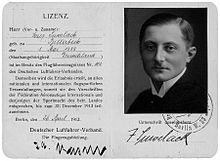Josef Suwelack (aviator)
Josef Suwelack (born April 30, 1888 in Billerbeck , Westphalia, † September 13, 1915 near Steenwerck ) was a German aviator in the First World War .
Life
His father Josef Suwelack was the founder and director of the Billerbeck steam dairy , his mother Katharina geb. Brockmann (1863–1946) was the daughter of Heinrich Brockmann (1829–1899), the founder of the Billerbecker Sparkasse. The mother survived seven of her ten children. The eleven years younger brother Wilhelm Suwelack - like Josef an avid aviator - fell on September 19, 1941 as a pilot and squadron captain near Melitopol ( Ukraine ) and was buried in Mykolaiv .
Josef Suwelack attended the Collegium Augustinianum Gaesdonck near Goch from 1902 to 1904 and then attended the Arnoldinum high school in Burgsteinfurt until he graduated from secondary school in 1906 . He then attended the art academy in Düsseldorf for a short time and attended lectures at the Technical University in Darmstadt for a semester . He finally found his real calling in aviation. The first foreign aviation pioneers, the American brothers Wilbur and Orville Wright , the Brazilian Alberto Santos Dumont (1873–1932) and the French aviation pioneer Henri Farman (1874–1958), of whom the press reported at the time, motivated Suwelack in 1909 to build flying machines himself . After first attempts in Billerbeck, he went to Berlin-Johannisthal in 1910 , where he obtained the pilot's certificate No. 102 from the German Aviation Association and became a flight instructor and chief pilot at E. Rumpler Luftfahrzeugbau GmbH Berlin. This made him one of the only 817 daring men and women who received a license to fly before the First World War and were later called the "Old Eagles". On December 8, 1911, he set a world record of four hours and 34 minutes that made him famous. In 1912 Josef Suwelack left Berlin and became technical director of the newly founded Kondor-Flugzeugwerke GmbH in Essen-Gelsenkirchen-Rotthausen. The Kondor aircraft he designed - a further development of the Etrich-Rumpler Taube - were distinguished by their elegance and good flight characteristics. The First World War ruined his initially successful efforts to sell aircraft in Spain.
On the day of mobilization, August 1, 1914, Josef Suwelack was assigned to Feldfliegerabteilung 24 (FFA) in Dresden, which was soon transferred to Lille (northern France). In letters and documents from this time he reported on his activities as a pilot. He stayed there until his death on September 13, 1915. The day before he wrote a farewell letter to his parents and siblings. On September 13, 1915, he and his companion, Lieutenant Oskar Teichmann (1889–1915), fell under circumstances that had not been finally clarified near Steenwerck and was buried in the English military cemetery in Erquinghem-Lys .
Awards
- Iron Cross 2nd Class (October 1914)
- Knight's Cross 2nd Class of the Order of Albrecht with Swords (December 1914)
literature
- Rainer A. Krewerth (Ed.): A Westphalian aviator life. Josef Suwelack 1888–1915. Munster 2001.
- Rebecca Quick: Josef Suwelack - aviation pioneer, entrepreneur, combatant. In: Niederrhein-Magazin. No. 17. 2014. pp. 3–12.
- Rebecca Quick: Josef Suwelack - aviation pioneer, designer and “civil war hero” (1888–1915). Approaching an aviator myth, Paderborn: Schöningh, 2018. ISBN 978-3-506-79298-3 .
- Winfried Suwelack, Walter Suwelack: Josef Suwelack and the dream of flying. Warendorf 1988.
- Robert Wright: The Forgotten Winner. Bergisch Gladbach 1970.
Web links
Individual evidence
- ↑ (On page 29 there is the following report by Major HCJ Dowding, how Josef Suwelack and his observer Lieutenant Oskar Teichmann probably died.) “During actual aerial battles at that time, the 16th squadron only brought down one enemy aircraft. It landed safely behind the British lines. 'The pilot and the observer were then shot in cold blood by soldiers passing by,' says Dowding of this incident, which still makes him angry today. 'I picked up your personal effects if they were not confiscated by the Intelligence Service and had them dropped behind the front with an improvised parachute, along with the notification of where the two airmen were buried.' "
| personal data | |
|---|---|
| SURNAME | Suwelack, Josef |
| BRIEF DESCRIPTION | German aviator and aircraft designer |
| DATE OF BIRTH | April 30, 1888 |
| PLACE OF BIRTH | Billerbeck , Westphalia |
| DATE OF DEATH | September 13, 1915 |
| Place of death | at Steenwerck |
